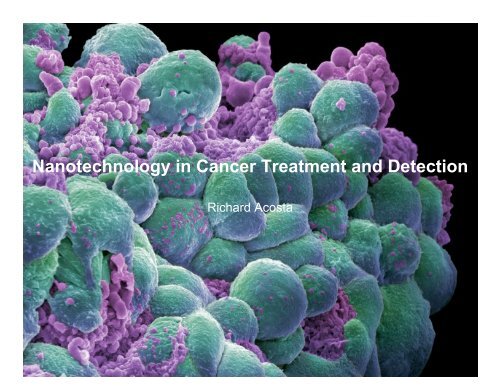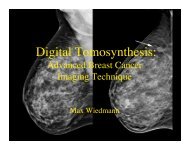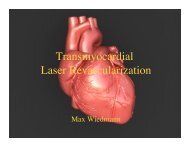Nanotechnology in Cancer Treatment and Detection
Nanotechnology in Cancer Treatment and Detection
Nanotechnology in Cancer Treatment and Detection
Create successful ePaper yourself
Turn your PDF publications into a flip-book with our unique Google optimized e-Paper software.
<strong>Nanotechnology</strong> <strong>in</strong> <strong>Cancer</strong> <strong>Treatment</strong> <strong>and</strong> <strong>Detection</strong><br />
Richard Acosta
Motivation<br />
• Ineffectiveness of many <strong>Cancer</strong> treatments<br />
• Numerous side effects<br />
• Difficulties <strong>in</strong> early <strong>Cancer</strong> detection<br />
• No immunization
The nanoparticles discussed <strong>in</strong><br />
this presentation are typically<br />
between 20-150 nm or roughly<br />
100 times smaller than most<br />
human cells<br />
<strong>Cancer</strong> <strong>Nanotechnology</strong> research<br />
is <strong>in</strong>terdiscipl<strong>in</strong>ary <strong>and</strong><br />
<strong>in</strong>corporates Biology, Chemistry,<br />
Eng<strong>in</strong>eer<strong>in</strong>g, Medic<strong>in</strong>e, <strong>and</strong><br />
Physics<br />
Scale <strong>and</strong> Scope
Properties of <strong>Cancer</strong> Cells<br />
• Epidermal Growth Factor Receptor (EGFR)<br />
over expression <strong>and</strong> over activity<br />
have been associated many different<br />
types of <strong>Cancer</strong><br />
• <strong>Cancer</strong> cells have a unique properties that can be exploited by nanoparticles<br />
• Their rapid rate of growth causes them to <strong>in</strong>take an abnormal amount of<br />
nutrients (i.e., folic acid)<br />
• Nanoparticles can be used to target bio-markers or antigens that are<br />
highly specific to <strong>Cancer</strong> cells
Nanoparticle Specialization<br />
• 99% of chemotherapy drugs do not reach the<br />
<strong>Cancer</strong> cells<br />
• Nanotubes, nanorods, dendrimers,<br />
nanospheres, nanoantennas, … us<strong>in</strong>g<br />
carbon, iron, gadol<strong>in</strong>ium, gold, silicon, etc.<br />
• Antigen b<strong>in</strong>d<strong>in</strong>g peptide lig<strong>and</strong>s are attached<br />
to the nanostructures<br />
• Folic acid bait<strong>in</strong>g<br />
• Passive target<strong>in</strong>g - Leaky blood vessels near<br />
tumors cause the nanoparticles to cluster<br />
around the tumors
Intracellular Drug Delivery<br />
The Trojan Horse<br />
Cytotoxic chemical payload<br />
Methotrexate, Docetaxel, etc…<br />
Uses <strong>in</strong> <strong>Treatment</strong>
Experiment on mice bear<strong>in</strong>g<br />
human prostate tumors<br />
After approximately 3 months<br />
100% of the mice treated with the<br />
targeted nanoparticles survived<br />
57% of the mice treated with<br />
untargeted nanoparticles survived<br />
14% of the mice with Docetaxel<br />
alone survived<br />
Uses <strong>in</strong> <strong>Treatment</strong><br />
Amount of weight loss <strong>and</strong> white<br />
blood cell count confirmed far lower<br />
toxicity for the targeted nanoparticles
©2006 by National Academy of Sciences<br />
Comparative efficacy study <strong>in</strong> LNCaP s.c. xenograft nude mouse model of PCa<br />
Farokhzad O. C. et.al. PNAS 2006;103:6315-6320
Photothermal Ablation<br />
Uses <strong>in</strong> <strong>Treatment</strong><br />
<strong>Cancer</strong> cells die at 42° C (108° F), normal cells die at about 46° C (115° F)<br />
Current optical fiber treatment<br />
Hollow, gold nanospheres are 50 times more effective at absorb<strong>in</strong>g light near the<br />
<strong>in</strong>frared than solid gold nanoparticles<br />
Nanoparticles can be tuned to be excited only by certa<strong>in</strong> ranges of light
Uses <strong>in</strong> <strong>Treatment</strong><br />
In another study, pre-cl<strong>in</strong>ical trials reveal that a s<strong>in</strong>gle <strong>in</strong>travenous nanoparticle<br />
<strong>in</strong>jection eradicated 100 percent of tumors <strong>in</strong> mice when exposed to<br />
near-<strong>in</strong>frared light.<br />
Most work is be<strong>in</strong>g done with near-<strong>in</strong>frared light, which is harmless to humans but<br />
can only penetrate human tissue about 1.5 <strong>in</strong>ches. Nanoparticles heated up<br />
to 70° C (160° F)<br />
The Kanzius RF Mach<strong>in</strong>e uses radio waves for dielectric heat<strong>in</strong>g
Uses <strong>in</strong> <strong>Detection</strong><br />
Gold nanoparticles <strong>in</strong> this image showed 600 percent more aff<strong>in</strong>ity to <strong>Cancer</strong><br />
cells than healthy cells (EGFR b<strong>in</strong>d<strong>in</strong>g)<br />
White light <strong>and</strong> simple, <strong>in</strong>expensive microscope is all that’s necessary for<br />
powerful ex vivo <strong>Cancer</strong> detection.<br />
The scatter<strong>in</strong>g is so strong that even one nanoparticle can be detected.
Uses <strong>in</strong> <strong>Detection</strong><br />
Us<strong>in</strong>g a metal-organic framework with metals such as gadol<strong>in</strong>ium or iron,<br />
nanoparticles can be used as MRI contrast agents<br />
For the same amount of contrast, only 1/3 of the contrast agent is necessary<br />
us<strong>in</strong>g nanoparticle target<strong>in</strong>g
Fluorescent Microscopy<br />
Uses <strong>in</strong> <strong>Detection</strong><br />
Nanoparticles can serve as dual detection devices for both magnetic<br />
resonance <strong>and</strong> microscopy
Current Limitations<br />
<strong>Cancer</strong> target<strong>in</strong>g is highly dependent on surface chemistry. Not just any<br />
nanoparticle will work.<br />
The need for biocompatible <strong>and</strong> stable nanoparticles<br />
Side-effects <strong>and</strong> toxicity<br />
Environmental impact<br />
Uncharted territory
Future<br />
Human cl<strong>in</strong>ical trials with<strong>in</strong> the next 2-3 years<br />
Highly specific team of communicat<strong>in</strong>g multifunctional nanoparticles used<br />
<strong>in</strong> the discovery, treatment, <strong>and</strong> prevention of <strong>Cancer</strong> growth<br />
Safer, more consistent, <strong>and</strong> highly specific nanoparticle production<br />
Turn<strong>in</strong>g <strong>Cancer</strong> <strong>in</strong>to a chronic, but manageable disease with<strong>in</strong> the next<br />
15-20 years
Summary<br />
-Different types of <strong>Cancer</strong> cells have unique properties that can be<br />
exploited by nanoparticles to target the <strong>Cancer</strong> cells<br />
-Nanoparticles can be used to detect/monitor (by utiliz<strong>in</strong>g or add<strong>in</strong>g optic,<br />
magnetic, <strong>and</strong> fluorescent properties) <strong>and</strong> to treat <strong>Cancer</strong> (by Heat ablation,<br />
chemotherapy, gene therapy).<br />
-No human trials have been performed yet <strong>and</strong> human trials are still at<br />
least a few years away. (Unknown side effects, toxicity, difficulty <strong>in</strong><br />
manufactur<strong>in</strong>g <strong>and</strong> harmful byproducts, need for highly specific<br />
nanoparticles)
Sources<br />
• University of California - Santa Cruz (2009, March 28). Hollow Gold Nanospheres Show Promise For Biomedical And Other<br />
Applications. ScienceDaily. Retrieved May 24, 2009, from http://www.sciencedaily.com- /releases/2009/03/090322154415.htm<br />
• University of Texas M. D. Anderson <strong>Cancer</strong> Center (2009, February 8). Targeted Nanospheres F<strong>in</strong>d, Penetrate, Then Fuel<br />
Burn<strong>in</strong>g Of Melanoma. ScienceDaily. Retrieved May 24, 2009,<br />
from http://www.sciencedaily.com- /releases/2009/02/090202074856.htm<br />
• Couvreur P, Vauthier C. <strong>Nanotechnology</strong>: <strong>in</strong>telligent design to treat complex disease. Pharmaceutical<br />
Research. 2006; 23(7): 1417-50.<br />
• Sunderl<strong>and</strong> CJ, Steiert M, Talmadge JE, Derfus AM, Barry SE. Targeted nanoparticles for<br />
detect<strong>in</strong>g <strong>and</strong> treat<strong>in</strong>g cancer. Drug Development Research. 2006; 67: 70-93.<br />
• Yih TC, Al-F<strong>and</strong>i M. Eng<strong>in</strong>eered nanoparticles as precise drug delivery systems. Journal of Cellular<br />
Biochemistry. 2006; 97: 1184-90.<br />
• El-Sayed, Mostafa. Gold Nanoparticles May Simplify <strong>Cancer</strong> <strong>Detection</strong>. Georgia Institute of Technology. 2005<br />
• Misty D. Rowe, Douglas H. Thamm, Susan L. Kraft, Stephen G. Boyes. Polymer-Modified Gadol<strong>in</strong>ium Metal-Organic Framework<br />
Nanoparticles Used as Multifunctional Nanomedic<strong>in</strong>es for the Targeted Imag<strong>in</strong>g <strong>and</strong> <strong>Treatment</strong> of <strong>Cancer</strong>.<br />
Biomacromolecules 2009 10 (4), 983-993<br />
• Chungang Wang, Jiji Chen, Tom Talavage, Joseph Irudayaraj. Gold Nanorod/Fe3O4 Nanoparticle Nano-Pearl-Necklaces for<br />
Simultaneous Target<strong>in</strong>g, Dual-Mode Imag<strong>in</strong>g, <strong>and</strong> Photothermal Ablation of <strong>Cancer</strong> Cells. Angew<strong>and</strong>te<br />
Chemie International Edition (2009)<br />
• L. Denton, Michael S. Foltz, Gary D. Nooj<strong>in</strong>, Larry E. Estlack, Robert J. Thomas, <strong>and</strong> Benjam<strong>in</strong> A. Rockwell. Determ<strong>in</strong>ation of<br />
threshold average temperature for cell death <strong>in</strong> an <strong>in</strong> vitro ret<strong>in</strong>al model us<strong>in</strong>g thermograph Proc. SPIE 7175,<br />
71750G (2009), DOI:10.1117/12.807861<br />
• Targeted nanoparticle-aptamer bioconjugates for cancer chemotherapy <strong>in</strong> vivo PNAS 2006 103:6315-6320; published onl<strong>in</strong>e<br />
before pr<strong>in</strong>t April 10, 2006, doi:10.1073/pnas.0601755103<br />
• http://en.wikipedia.org/wiki/Epidermal_growth_factor_receptor<br />
• http://en.wikipedia.org/wiki/Nanomedic<strong>in</strong>e<br />
• http://en.wikipedia.org/wiki/Surface_plasmon_resonance<br />
• http://en.wikipedia.org/wiki/Fluorescence_microscopy<br />
• http://en.wikipedia.org/wiki/Methotrexate<br />
• http://en.wikipedia.org/wiki/Docetaxel
Questions<br />
1) Which of the follow<strong>in</strong>g are not potential methods for treat<strong>in</strong>g <strong>Cancer</strong><br />
us<strong>in</strong>g nanotechnology.<br />
a) Photothermal ablation<br />
b) Folic acid <strong>in</strong>troduction<br />
c) Cytotoxic drug delivery<br />
d) Gene therapy<br />
e) None of the above<br />
2) A cause for the stall <strong>in</strong> utiliz<strong>in</strong>g nanotechnology treatment on a mass scale is<br />
a) Unknown toxic effects of nanoparticles<br />
b) Environmental repercussions<br />
c) Lack of human cl<strong>in</strong>ical trials<br />
d) Inefficient nanoparticle creation techniques<br />
e) All of the above




